
“Bill Gates said what?”
Rumor has it that billionaire-philanthropist and Microsoft-founder once said that “640K is more memory than anybody would ever need.” This was supposedly uttered by Mr. Gates during the early years of the PC revolution.

Rumored quote from Bill Gates in the 80’s!
Now there has never really been a clear citation for this outrageous slander but this rumor has floated on the internet since its inception. Nobody really knows whether he meant Random Access Memory (RAM) or Storage Space Memory, because as some resourceful journalism would unravel, the man never actually said it. Nonetheless, this quote has been circling the internet for quite some time, and it has been used to make a point of the way the computing industry has grown by leaps and bounds in terms of the amount of raw computing power and the amount of data and information that us normal humans have processed in the last four decades.
1 selfie = $50,000.00
Consider this. Sixty-five years ago, when the first hard drive was created by IBM engineers, the cost to manufacture it was a whopping $10,000.00 per megabyte (mb). Fast track to year 2018, a low resolution selfie taken on the ubiquitous iPhone, takes up around 5 mb. That would have cost you $50,000.00 back in the day ! Pet photography could never have been a thing in the 70’s !

1 Selfie would cost $50,000 in 1954.
1 iPhone = 150,000 photos
But nowadays, we take all of these for granted. An average iPhone user will have hundreds, if not thousands of pictures taken every year. When the very first iPhone came out in 2007, it had a capacity of 8GB. In the fall of 2018, the iPhone XS came out with a 512GB storage capacity. That’s enough to hold approximately 150,000 photos. Where does it end ?

iPhone XS with 512GB capacity can hold at least 150,000 photos !
In order for us to truly understand and appreciate the concept of data storage and its preservation, we need to go back in time and study its history. Why and how it was made, its evolution, and where it’s heading for the generations to come. It might be a little boring, but hey… “the more you know!”
“Father” of the Hard Disk Drive
International Business Machines (IBM), nicknamed “Big Blue”, was the company that invented the very first hard disk drive back in 1954. The IBM team that was credited with this invention was led by an American inventor and computer pioneer named Reynold B. Johnson. A life-long IBM employee, he is said to be the “Father” of the Hard Disk Drive. Mr. Johnson was hired by IBM in the early 1930’s and in 1952, he was assigned to lead the research team to develop the Disk Data Storage Technology. Two years later, the RAMAC 305 was born.
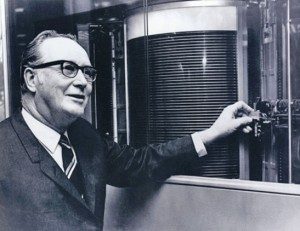
Reynold B. Johnson is said to be the “Father” of the Hard Disk Drive. Shown here with the RAMAC 305, the world’s first hard drive by IBM.
RAMAC which stands for “Random Access Method for Accounting and Control,” was the first commercial hard disk drive-based computer. This first iteration of magnetic storage technology is still the basis for the technology used in today’s modern hard disk drive. It hallmarks a moving magnetic head to store and extract data from a magnetic medium more commonly called disks or platters.
By modern standards, the RAMAC 305 was a very crude invention since the machine, which was the size of two refrigerators, weighed over a ton, took the space of an entire room, and could only store 3.75 mb of data into 50 disks of 24-inch diameters each. Its original purpose was for real-time accounting and computing industries, but because it costs an arm and a leg to manufacture, only the US Military and other blue-chip corporations could afford to test the machine in its first production run.
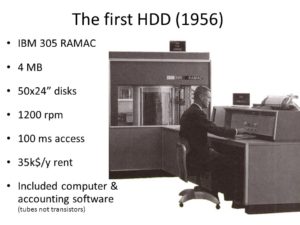
The RAMAC 305 filled an entire room and weighed over a ton.
In the succeeding years, IBM had drastically improved storage density, improved access times, reduced mainframe sizes, and ultimately reduced sticker prices for the majority of their customers, which by then, had included Universities and other big businesses. Up until the late 1970’s, IBM’s most advanced hard drive could only store up to 1GB of storage, but was still not very consumer-friendly, as it still weighed 500 pounds and costs $44,000 a pop.
Hungry for more….
By mid-70’s, the PC revolution had really started to ramp up, and businesses and consumers alike were clamoring for more storage capacity, affordability, and portability.
And in 1980, a brilliant start-up company called Shugart Technology (named after co-founder Al Shugart), which was later renamed to Seagate Technology, developed the very first consumer-grade hard disk drive. It was the ST-506. This was the company’s first product, and it would store 5mb of data at a cost of $1,500.00. While this was a drastic reduction in cost, what would make this the de facto standard for storage drives for PC’s at that time was its size. At a 5.25-inch diameter disk size, this “mini-floppy” drive form factor would drive Seagate into the Silicon Valley goliath that it has become up to this day. In its first year, Seagate delivered $10 million worth of hard drives to its customers, mostly to IBM, and it hasn’t stopped since. As of this writing, it has a market cap of over 12 billion USD, and has no signs of slowing down.

Seagate Technology’s ST-506
Some milestones…
In 1983, a little-known company, called Rodime PLC, based in Scotland, launched the world’s first 3.5-inch hard drive. The company failed to capitalize on this technological breakthrough and it went out of business soon after. This 3.5-inch hard drive size would however, become a standard form-factor for many years to come, even to this day, especially for desktop computers. One could say that this company suffered, what we in the industry would call, a major “hard drive crash!”

2.5″ vs 3.5″ hard drives from Seagate.
In 1985, Western Digital, in collaboration with Compaq and Control Data, developed the 40-pin IDE interface ( IDE stands for Integrated Drive Electronics ), which would set the industry standard for the majority of hard drive interfaces. IDE is oftentimes called PATA which stands for Parallel Advanced Technology Attachment.
In 1988, when the laptop market was started by Compaq, another start-up called Prairie Tek, based in Colorado, developed the very first 2.5-inch hard drive. Again, up to this day, and probably for many more years to come, this would stand up to the test of time, as the prevailing form factor for affordable and reliable hard disk drives.
In 1992, Seagate once again leads the way in introducing the first 7200 revolutions per minute (rpm) hard drive with its flagship product, the Seagate Barracuda series.
In 2002, Seagate produces the first SATA-connected drive with its Barracuda ATA V series. SATA stands for Serial AT Attachment. A huge improvement from the previous PATA interface, the SATA connections would soon replace the traditional PATA for 99% of all desktop and laptop hard drives even up to now.
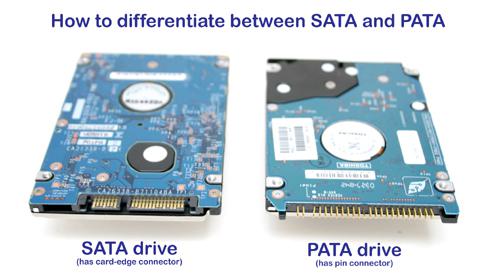
SATA drives vs PATA drives
In 2003, IBM ends its hard disk drive business and sells that division to Hitachi Corp. Two years later, IBM also sold the entirety of its PC hardware business to Chinese hardware manufacturer Lenovo. Lenovo would soon become the world’s No.1 PC manufacturer behind the strength of its Thinkpad line of laptops.
In 2007, the SSD revolution had started to get noticed. SSD stands for Solid-State Drives. This type of storage device uses flash memory and has no moving and mechanical components that are found in traditional hard disk drives. SSD’s have faster access times, lower defect rates, but are quite expensive to produce. While the first SSD’s were introduced back in 1991 by Sandisk, it was only in 2007 where its full functionality and economic market viability were truly realized.

HDD vs SSD Comparison
In 2013, laptops shipped by Apple’s flagship Macbook line all shipped with Solid-State Drives. Some desktops still had the traditional hard drives coupled with an SSD to combine both speed and storage space requirements.
Now Trending…
Dating back to the very first hard drive ever produced, there have been over 200 companies that have manufactured hard drives in the past. And whether it was through strategic mergers and acquisitions, or bankruptcies due to mismanagement or poor product design, most of them have vanished. Only three major companies now exist. Seagate, Western Digital, and Toshiba (which is also currently undergoing a management crisis). Survival of the fittest, or in this case, the fastest, was and will continue to be the driving force in capturing a bigger piece of the hard drive market. All this jostling for position in the market has benefited the consumer as hard drive companies have strived to produce faster, smaller, and more reliable storage drives as we continue to amass huge amounts of data, that of which about 99% have been produced only in the last 5-10 years.
In a recent study sponsored by Seagate called Data Age 2025, it foresees that the world will be producing data at a rate of 163 Zettabytes per year by 2025. A tenfold increase compared to 2016 data. It would be like watching the entire Netflix catalog 400 million times. I have honestly never heard of zettabytes up until I started writing this article but it apparently is equivalent to 1 trillion gigabytes (1 zb = 1 trillion gb). Your standard calculator would run out of zeroes trying to convert these units.
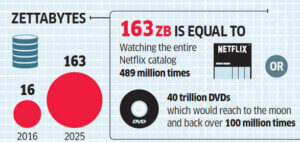
1 Zettabyte = 1 trillion Gigabytes !
Final Thoughts…
The world is awash with data and will continue to grow exponentially in the next few years. As long as You Tubers continue to churn out daily blogs to get those subs, there is no end in sight. Luckily, innovation and development of hard drives are continuing at a staggering pace, so there is no consternation of it becoming irrelevant. Seagate’s CFO has predicted that hard drives will continue to be around for another 15-20 years and it will be better, faster, and have bigger capacities.
I personally predict, that in a few years, there will be an iPhone with a 10 Terabyte (TB) capacity. You laugh now! But didn’t we all, when we first read that article with that infamous Bill Gates quote. See you in a few years and we’ll see who get’s the last laugh!
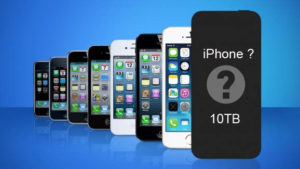
Future prediction = 10TB iPhone
Finally, as people store more and more data, never has there been a time and a need to have a safe way to store your digital archives. Yes you can have your photos printed similar to the Polaroid photos that your Grandma once took, but you can only have so many shoe boxes to store them into. Storing them into hard disk drives are the best way to go, but they can also fail at some point. It is in these unfortunate instances that a data recovery company with a good reputation, high success rates, and pricing that will not break the bank, comes in handy. BYOD Computer Services is one such company. BYOD Computer Services has hundreds of five-star reviews from Yelp, Google, Facebook, Angie’s List, and other popular social media sites, which is a testament to their dedication and commitment to provide their customers with top-notch service at affordable rates. They specialize in data recovery services for hard drives, RAID Drives, SD and Memory Cards, USB Flash Drives, and iPhone data recovery.
Data loss can happen to anyone. The only way to prevent this is to have multiple backups. Do it now. Sometimes later becomes never. But should it happen, BYOD will be here to help!


Affordable Data Recovery starting at $149.00 !
